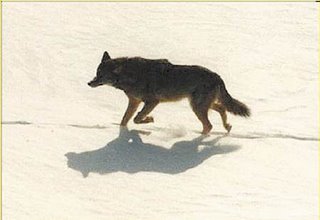Wolf tracking in the Canadian wilderness

By Dan Gardoqui
It’s 15 degrees Fahrenheit - tops. The wind’s blowing 15-25 mph and I haven’t seen the sun in days. My arms slowly numb under two layers of wool. I pull on my hat. My back, hauling 30 pounds of food, clothing, and safety gear, is soaked in sweat. I take the hat off. Big, wood and rawhide snowshoes sink deep into the powdery snow with each labored step as I climb atop yet another hill and let the group catch up.
"Thank God for this downhill," I’m thinking. As we descend, I spot a dark shape moving out on the ice.
"Could that be a…? Wait…it’s behind the cedars…There it is! I can’t believe it!"
Waving my arms wildly, I signal to the group, pointing to the ice.
Tracking wildlife takes me to beautiful, remote places. One such place is Algonquin Provincial Park in Ontario, Canada. With more than 2,700 square miles of northern forest, lakes, streams and rivers, Algonquin is a jewel in the Canadian Parks System. Just a half-day’s drive from Toronto and Ottawa, the park is a known for summer canoeing and camping. What most people don’t know is what an amazing place the park is for winter wildlife study.
Every winter for the past eight years, I’ve guided groups on wildlife expeditions in Algonquin Park. Each year, our group is amazed at the abundance of winter wildlife the park is host to. Journals from the past few years included sightings of shrew, mouse, moose, deer, marten, river otter, fisher, mink, ermine, and red fox. Algonquin is also home to the eastern wolf (Canis lycaon), a distinct species from the gray or timer wolf (Canis lupus). Eastern wolves are closely related to the endangered red wolf (Canis rufus) of the Gulf Coast of Texas and Louisiana. At a quick glance, a New Englander might mistake an eastern wolf for a eastern coyote (Canis latrans var.) because of its size. Regardless of their genetics, these canines are wild wolves - regularly preying on big game such as white-tailed deer and moose throughout the winter.
I awake each dawn, layer up, and head our scouting for fresh tracks. Day after day, I find no wolves. It’s day five of six and beginning to look like a wolf-free year.
"Bummer," I’m thinking. Just minutes later, a wolf biologist delivers good news at breakfast: Fresh tracks just nine clicks (Canadian for kilometers) down the road. A group of trackers piles into my wagon and zips off. Seeing the fresh wolf tracks is like a chance reunion with an old friend. I smile. My body smiles. The group’s abuzz as we begin backtracking a lone wolf.
Did I mention the snow? Unlike the Seacoast, Algonquin Park experienced a real winter. With an average of four feet of snow in the "bush" (Canadian for "woods"), snowshoeing is both an aerobic activity and an art. OK, back to the story.
The first hour of the wolf’s trail is littered with red fox tracks. Next, we spy tracks of a ruffed grouse (or "pah-tridge" if you’re a Mainer). Atop a small hill of balsam fir and poplar, we find a scat (i.e. "poop") which we dutifully collect for the biologists to analyze later (using microscopes, they determine prey species by hairs in the scat).
Our clumsy, heavy steps contrast with the clean, straight trail of a trotting wolf. The animal doesn’t break from its rhythmic, efficient gait…one kilometer…two kilometers…three kilometers…still trotting. We stop to study the map. Finally, the trail diverts toward an outstretched branch of a white pine kissing the top of the snowpack. We notice a yellow stain, then red drops in the snow. "Is that blood?" asks a student." "It sure is. Looks like we’re on the trail of a female wolf that’s ready to breed." (Female wolves, like many other mammals, bleed when they’re in estrus, or "in heat").
"Thank God for this downhill," I’m thinking. As we descend, Whitefish Lake comes into view, a massive, sprawling sea of white, dotted with dark green islands of evergreen. I spot a dark shape moving out on the ice.
"Could that be a….? No? Wait…it’s behind the cedars…There it is! I can’t believe it!" Waving my arms wildly, eyes open wide, I signal to the group and hear myself whisper-shouting "wolf!" Even at 200 yards, the profile is unmistakable - a large oval head with pointed ears, long body with a thick, dark tail trailing behind. For everyone in the group, including myself, it’s the first eastern wolf seen in the wilds. We’re silent, living fully in this moment - stretching it out as long as we can - knowing it’s special. The wolf turns away, then looks back, and finally, gallops eastward, aiming for a break in the rocky cliffs where a frozen brook tumbles under a blanket of snow and pours into the icy lake.
Encounters like these always resonate deeply with me. I’m reminded of the millions of years that our ancestors lived as hunter-gatherers, dependent upon tracking for survival. That long-lost lifestyle demanded a quality of attention to the natural world that very few people possess today. It’s only been a few thousand years since we dropped the spears and digging sticks in favor or the plow and cell phone. A deep connection to nature is hardwired into our DNA. This story of wolf tracking in the Canadian wilderness is a reminder of not only our past, but of who we are today, Homo sapiens - a successful, inquisitive mammal on planet earth.
Algonquin Park info: www.algonquinpark.on.ca.

0 Comments:
Post a Comment
<< Home